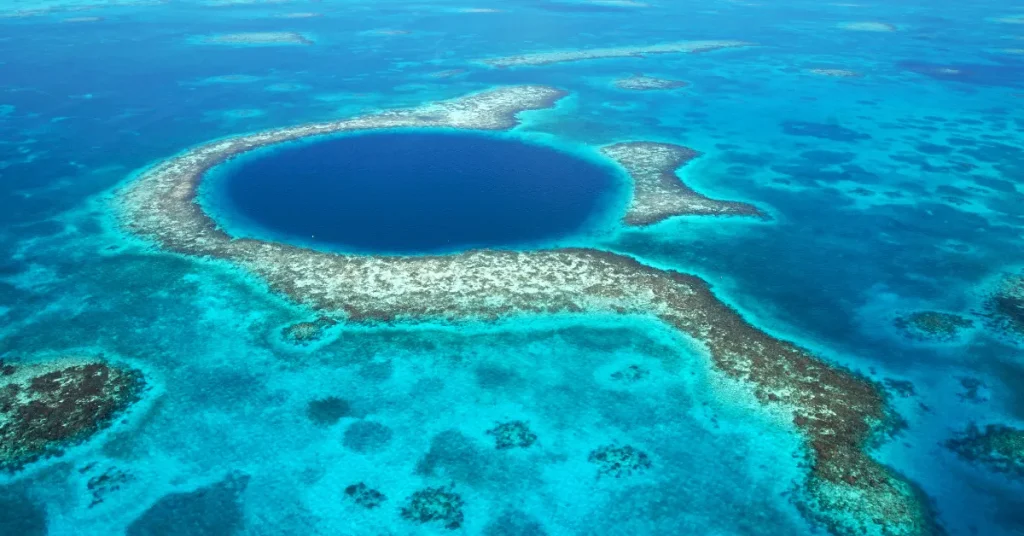The Big Blue Hole is approximately 410 feet deep. It is located in the Belize Barrier Reef Reserve System.
Discover the Great Blue Hole, a giant marine sinkhole off the coast of Belize. Known for its circular shape and deep blue color, it is one of the most stunning underwater sites in the world.
This remarkable submarine sinkhole draws scuba divers eager to explore its mysterious depths.
With an almost perfect circular diameter of about 1,000 feet, the Great Blue Hole offers a gateway to a unique underwater habitat. Famed oceanographer Jacques Cousteau declared it one of the top scuba diving sites on the planet.
The site’s depth creates a habitat for unique species and offers insights into Earth’s geological history. The Big Blue Hole remains a bucket-list destination for divers and ocean explorers from around the globe.

The Lure Of The Abyss
The Big Blue Hole, an underwater chasm of mystery and allure, captivates the human imagination like few other places on Earth.
Known for its stunning color contrast and depth, adventurers and scientists alike are drawn to its enigmatic depths.
Tales And Myths Surrounding The Deep
Legends have long swirled around the Big Blue Hole. Escaping the realm of reality, these stories stimulate curiosity.
- Atlantis: Some believe it’s a passage to the lost city.
- Sea Monsters: Others talk of gigantic creatures lurking below.
- Ancient Mayans: A sacred site for rituals, perhaps?
Every tale is a piece of the mosaic that build its allure.
The Call To Adventure And Exploration
Explorers are lured to the Big Blue Hole by the challenge it presents.
- Professional divers: Venture to uncover its secrets.
- Marine biologists: Study its unique habitat.
- Environmentalist: Seek to preserve its pristine condition.
Each expedition brings the thrill of the unknown and the prospect of discovery.
The Big Blue Hole: Geological Marvel

Nestled in the tranquil waters of Belize, the Great Blue Hole is a natural wonder that has captivated explorers and scientists alike.
This submarine sinkhole, renowned for its staggering depth and unique appearance from above, is a geological treasure trove that offers insights into Earth’s natural history.
Formation Of The Great Blue Hole
The Great Blue Hole did not always exist as the watery abyss we see today. Its story began millions of years ago during the last glacial period.
- Originally, the hole was formed as a limestone cave.
- As sea levels rose, the cave flooded and its roof collapsed.
- This created the circular sinkhole, now filled with water.
- The process of stalactite formation within further proves its ancient origins.
Comparative Depth Analysis
To fully appreciate the sheer depth of the Great Blue Hole, a comparison with other renowned underwater sites is essential.
| Location | Depth (meters) | Depth (feet) |
| Great Blue Hole, Belize | 124 | 407 |
| Dean’s Blue Hole, Bahamas | 202 | 663 |
| Zacatón Sinkhole, Mexico | 339 | 1,112 |
While not the deepest, the size and perfect circular shape make the Great Blue Hole extraordinary.
Diving Into The Depths
The Big Blue Hole is a marvel for divers worldwide. Its mysteries lie below the surface, where only the brave venture. This submarine sinkhole off the coast of Belize measures over 300 meters across and plummets to approximately 124 meters at its deepest point.
Notable Expeditions And Findings
Explorers have been captivated by the Big Blue Hole for decades. Noteworthy missions have enhanced our understanding of this underwater cave.
- Jacques Cousteau – His 1971 expedition on the Calypso put the Big Blue Hole on the map for the diving community.
- 2018 – The Great Blue Hole Expedition – This mission included entrepreneur Richard Branson and revealed detailed maps using submersible technology.
Findings from these quests range from ancient stalactites to proof of past earthquakes.
Challenges In Deep-sea Diving
Diving into the abyss of the Big Blue Hole is no small feat. Divers face unique challenges such as:
| Challenge | Impact on Divers |
| Decompression Sickness | Requires regulated ascent to prevent ‘The Bends’ |
| Limited Visibility | Navigational difficulties below 15 meters |
| Nitrogen Narcosis | Altered state of mind at extreme depths |
Technical expertise, proper equipment, and thorough planning are essential for a safe dive.
Biodiversity And Ecological Significance
The Great Blue Hole is not only deep but alive with nature. This underwater sinkhole off the coast of Belize is a hub for diverse marine life. Its walls teem with a vast array of species that form an essential part of the ocean’s ecosystem.
The ecological significance of the Big Blue Hole attracts scientists and nature lovers alike. This stunning natural wonder offers a window into the intricate balance of marine biodiversity.
Marine Life Within The Deep Blue
Explorers of the Great Blue Hole dive into a world teeming with life. The cool, dark depths attract a variety of creatures. Here’s what divers often witness:
- Midnight parrotfish grazing on algae
- Caribbean reef sharks patrolling the waters
- Colorful corals clinging to steep walls
- Groups of hammerhead sharks on rare occasions
Diving deeper, life forms change. Light-loving species give way to organisms adapted to darker waters. The biodiversity in this vertical slice of the sea is astonishing and invaluable to science.
Ecological Impact And Conservation Efforts
The health of the Big Blue Hole affects life far beyond its walls. Changes here can signal shifts in the wider marine environment. Recognizing this, Belize has taken steps to preserve the site:
- Inclusion in the UNESCO World Heritage Site list
- Implementation of sustainable tourism practices
- Research initiatives to monitor health of marine ecosystems
Conservation efforts focus on two areas: protecting resident species and ensuring water quality remains high.
Both measures aim to maintain the hole’s role in the larger oceanic life cycle. The Great Blue Hole stands as a testament to the beauty and fragility of our underwater world.
Mysteries Unveiled

The Big Blue Hole, a marine chasm off the coast of Belize, captivates the mind with its sheer depth and enigmatic past. This dark sapphire gem in the Caribbean sea calls to adventurers and scientists alike, beckoning them to uncover its secrets.
As we dive into the ‘Mysteries Unveiled,’ every discovery reshapes our understanding of this natural wonder.
Scientific Discoveries And Ongoing Research
Over the years, the Big Blue Hole has been a focal point for scientific exploration. Not only is it an underwater spectacle, but it is also a treasure trove of information about Earth’s history.
Researchers have uncovered submerged cave formations and rare geological features that suggest important shifts in sea levels and climate change events.
- Depth measurements confirm that the hole plunges to approximately 124 meters (407 feet).
- Specialized submersible technology enables scientists to map the interior in 3D.
- Studies on stalactites found inside indicate periods of dryness, aligning with the Ice Age.
| Year | Discovery |
| 2018 | Expedition led by Sir Richard Branson and Fabien Cousteau |
| 2019 | Discovery of never-before-seen stalactites |
| 2021 | New species of bacteria identified |
These scientific pursuits offer insights but also pave the way for future investigations—an unending quest for knowledge.
Unanswered Questions And The Horizon Of The Unknown
Despite numerous expeditions, the Big Blue Hole keeps much of its story shrouded in mystery.
The deep recesses and lack of light create an environment where modern equipment is tested to its limits. Here, the horizon of the unknown stretches out before us.
- What ecosystems thrive in the deeper, oxygen-deprived layers?
- How does the hole’s unique environment affect marine life adaptation?
- Could the Big Blue Hole hold valuable clues to the ancient Maya civilization?
Each unanswered question beckons a new generation of explorers and researchers. The allure of the unknown challenges humanity to push the boundaries of science and discovery.
As it stands, the Big Blue Hole remains a beautiful enigma, nestled in the ocean’s embrace, guarding its secrets just beneath the waves.
FAQs About How Deep Is The Big Blue Hole
What Is The Depth Of The Big Blue Hole?
The Big Blue Hole is approximately 124 meters (407 feet) deep. It’s a submarine sinkhole off the coast of Belize.
Can You Dive In The Big Blue Hole?
Yes, scuba diving is allowed in the Big Blue Hole. It’s a popular spot among experienced divers due to its unique underwater caves and marine life.
How Was The Big Blue Hole Formed?
The Big Blue Hole was formed as a limestone cave system during the last ice age. It collapsed and became a marine sinkhole as sea levels rose.
What Marine Life Inhabits The Blue Hole?
The Blue Hole is home to various marine species, including reef sharks, midnight parrotfish, and giant groupers, among others.
Conclusion
The Big Blue Hole holds many secrets beneath its tranquil surface. Diving into its depths, enthusiasts discover a world beyond the ordinary, mesmerizing explorers with its beauty and mystery.
At about 124 meters deep, it promises an unforgettable adventure for those seeking to unravel its underwater enigma.
Dare to explore this natural wonder and be part of its awe-inspiring story.
Resources:
1. https://oceanexplorer.noaa.gov/explorations/20blue-holes/welcome.html
